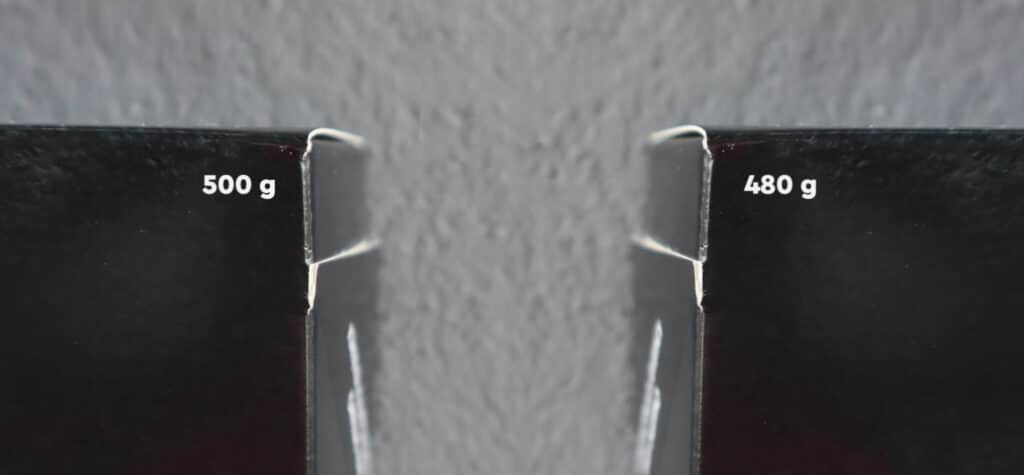The Consumers’ Union of Finland looked into how common subtle product shrinkage is. Shrinkflation is typically discussed when a product’s content decreases without a corresponding reduction in the selling price. Over 700 consumers reported their observations of reduced product sizes through a survey on The Consumers’ Union of Finland’s website. Notably, specific products and product categories recurred in the responses. The Consumers’ Union of Finland calls for clear and open communication about changes in packaging sizes.
“Consumers have clearly been awake and noticed the shrinkage of products, as we received a massive surge of responses within a few weeks of opening the survey,” says Paula Pessi, Head of Communications at The Consumers’ Union of Finland. “We received a total of 735 observations of reduced products.”
Based on consumer reports pet foods in particular have shrunk. Significant amount of observations were also submitted for products such as spreads, pollock, cheese, and meat products. ‘Shrinkage appears to be particularly evident in these products and categories, given the high number of similar observations,’ assesses Pessi.
Consumers reported on these products – 9 in particular gathered numerous observations
Products that had at least five similar submissions of suspected shrinkage were selected from the responses. It should be noted that the results are based on consumers’ own reports, and information about changes in size or price has not been verified. The highest number of reports were submitted of pet food. Shrinkage in wet cat food portion pouches was reported a total of 34 times (Latz and Whiskas). There were also 6 submissions regarding dog food (Jahti&Vahti).
The second highest number of observations were submitted of various meat products by Kivikylä (23 instances). Moreover, 20 consumers noticed a reduction of 100 grams in the Ingmariini spread container. The content size of different containers of Becel spreads seemed to have decreased by a few tens of grams (15 observations). Similarly, 14 respondents observed a reduction of 50 grams in the content of Oivariini spread from its previous size. 12 respondents reported a loss of 100 grams in Arla’s Endless cream cheese. According to the respondents’ reports, K-Group’s Pirkka Alaska pollock portion package now contains only 3 pieces instead of the previous 4, and the weight has decreased from 400 grams to 300 grams (10 observations).
Can all shrinkage be attributed to shrinkflation?
Manufacturers presented various reasons for the reduction in product sizes. Some highlighted that smaller packages were in line with consumer preferences. For instance, Kivikylä provided evidence of a concurrent price reduction. “It’s crucial to check if the selling price has genuinely decreased in tandem with the product size. In such cases, the consumer doesn’t lose out.”, Paula advises.
The reduction in product quantity without a corresponding price reduction has become to be called shrinkflation or hidden inflation. The content shrinks, but the selling price, and often the physical size and overall appearance of the package, remain the same as before. Reducing content may be a strategy to avoid raising prices.
“Proving whether a product has genuinely shrunk, especially from the consumer’s viewpoint, becomes challenging later on,” remarks Pessi. “There’s often a sense that the product has changed, but without retained receipts and with packages already discarded, there’s nothing left for comparison or proof. To confirm whether the package has indeed shrunk, both information about alterations in content and any changes in price are essential. Fortunately, nowadays, opting for an electronic receipt saved to an app is common. Consumers can also stay vigilant by monitoring shifts in kilo and liter prices,” reflects Pessi.
“Operators have the freedom to determine package sizes and prices, but altering sizes without transparent communication about these changes could jeopardize consumer trust. If you realize your favorite product has subtly shrunk, it might leave you with a sense of being deceived,” says Pessi and notes that this sentiment was evident in the responses The Consumers’ Union of Finland received.
Open communication about shrinkage needed
A potential gray area in marketing arises when reductions in product size are intentionally downplayed for undisclosed reasons. The Consumers’ Union of Finland contemplates whether marketing might be deemed misleading if the package size, including its content, is diminished, say by one-fifth, without open communication to consumers, while marketing tactics persist unchanged. The survey findings have been submitted by The Consumers’ Union of Finland to the Finnish Competition and Consumer Authority.
The Consumer Union also has a message for companies: if products are shrunk, communicate about it openly to consumers. Retailers can also play a role of their own. For example, a well-known retail chain in France announced that it would warn consumers about products with reduced package sizes but unchanged prices.
How was the survey conducted?
The open survey was published on the Consumer Channel of The Consumers’ Union of Finland and it was available from March 24 to August 31, 2023. A total of 735 responses were received, with the majority coming in the first month. The survey was answered anonymously.
The Consumers’ Union of Finland emphasizes that the survey responses are consumers’ own observations and suspicions of product size reduction. The information about changes has not been verified. The Consumers’ Union of Finland has been in contact with manufacturers and offered them the opportunity to comment on the results.


